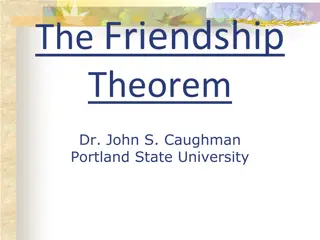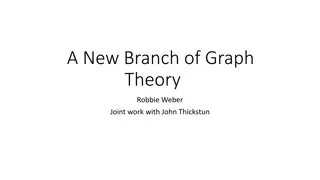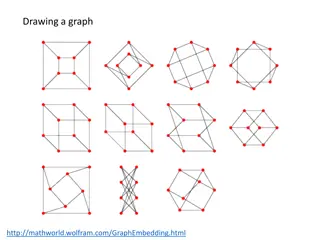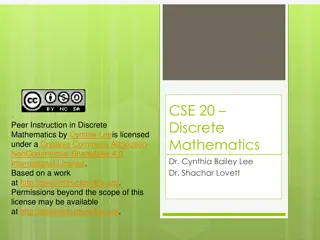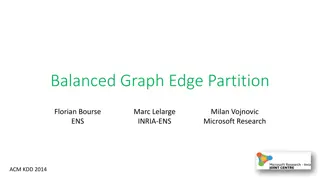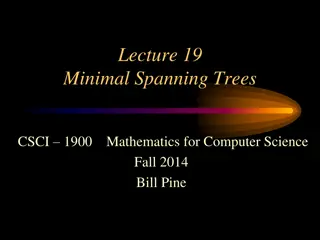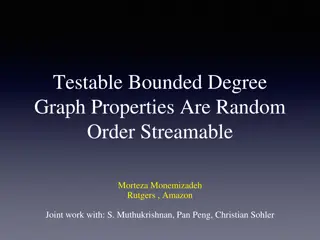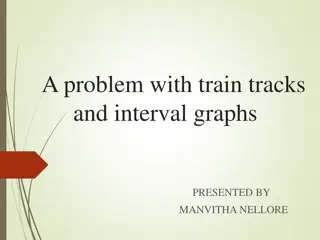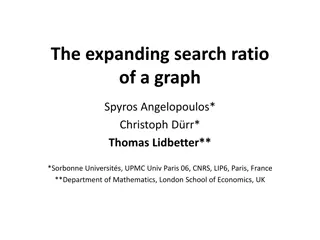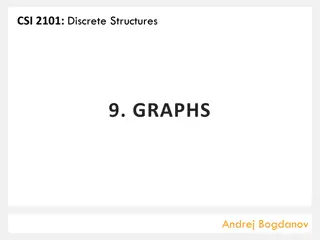
Graph Theory: Extremal Results and Theorems
Explore extremal graph theory concepts such as Mantel's and Turan's theorems, complete multipartite graphs, and proof techniques. Understand key results like maximum edge configurations in graphs without certain subgraphs.
Download Presentation

Please find below an Image/Link to download the presentation.
The content on the website is provided AS IS for your information and personal use only. It may not be sold, licensed, or shared on other websites without obtaining consent from the author. If you encounter any issues during the download, it is possible that the publisher has removed the file from their server.
You are allowed to download the files provided on this website for personal or commercial use, subject to the condition that they are used lawfully. All files are the property of their respective owners.
The content on the website is provided AS IS for your information and personal use only. It may not be sold, licensed, or shared on other websites without obtaining consent from the author.
E N D
Presentation Transcript
Extremal Graph Theory Ajit A. Diwan Department of Computer Science and Engineering, I. I. T. Bombay. Email: aad@cse.iitb.ac.in
Basic Question Let H be a fixed graph. What is the maximum number of edges in a graph G with n vertices that does not contain H as a subgraph? This number is denoted ex(n,H). A graph G with n vertices and ex(n,H) edges that does not contain H is called an extremal graph for H.
Mantels Theorem (1906) 2 n = ( , ) ex n K 3 4 The only extremal graph for a triangle is the complete bipartite graph with parts of nearly equal sizes.
Turans theorem (1941) 2 t 2 ( , ) ex n K n t ) 1 ( 2 t Equality holds when n is a multiple of t-1. The only extremal graph is the complete (t-1)- partite graph with parts of nearly equal sizes.
Proofs of Turans theorem Many different proofs. Use different techniques. Techniques useful in proving other results. Algorithmic applications. BOOK proofs.
Induction The result is trivial if n <= t-1. Suppose n >= t and consider a graph G with maximum number of edges and no Kt. G must contain a Kt-1. Delete all vertices in Kt-1. The remaining graph contains at most ( )2 1 ) 1 ( 2 t 2 t edges. + n t
Induction No vertex outside Kt-1 can be joined to all vertices of Kt-1. Total number of edges is at most 1 t 2 t ) 1 + + + + 2 ( ( 1 )( ) 2 n t n t t ( ) 2 2 1 t 2 t = 2 n ) 1 ( 2 t
Greedy algorithm Let v be a vertex with maximum degree . The number of edges in the subgraph induced by the neighbors of v is at most t 3 t 2 ( 2 ) 2 Total number of edges is at most t 3 t + 2 ( ) n ( 2 ) 2
Greedy algorithm This is maximized when 2 t = n 1 t The maximum value for this is 2 t 2 n ) 1 2 ( t
Another Greedy Algorithm Consider any graph that does not contain Kt. Duplicating a vertex cannot create a Kt. If the graph is not a complete multipartite graph, we can increase the number of edges without creating a Kt. A graph is multipartite if and only if non- adjacency is an equivalence relation.
Another Greedy Algorithm Suppose u, v, w are distinct vertices such that vw is an edge but u is not adjacent to both v and w. If degree(u) < degree (v), duplicating v and deleting u increases number of edges, without creating a Kt. Same holds if degree(u) < degree(w). If degree(u) >= degree(v) and degree(w), then duplicate u twice and delete v and w.
Another Greedy Algorithm So the graph with maximum number of edges and not containing Ktmust be a complete multipartite graph. Amongst all such graphs, the complete (t-1)- partite graph with nearly equal part sizes has the maximum number of edges. This is the only extremal graph.
Erds-Stone Theorem What can one say about ex(n,H) for other graphs H? Observation: ) , ( H n ex ( , ) ex n K (H ) (H) is the chromatic number of H. This is almost exact if (H) >= 3.
Erds-Stone Theorem For any > 0 and any graph H with (H) >= 3 there exists an integer n0such that for all n >= n0 + ( , ) 1 ( ) ( , ) ex n H ex n K (H ) What about bipartite graphs ( (H) = 2)? Much less is known.
Four Cycle 3 = ( , ) ( ) ex n C n 2 4 For all non-bipartite graphs H = 2 ( , ) ( ) ex n H n
Four Cycle Consider the number of triples (u,v,w) such that v and w are distinct neighbors of u. The number of such triples is i d 2 n = i 1 diis the degree of vertex i. The number of such triples can be at most n 2
Four Cycle n = = i = 2 d m If i 1 i d 2 2 n m i = then n 1 which implies the result.
Matching A matching is a collection of disjoint edges. If M is a matching of size k then k 2 1 1 k = + + ( , ) max , ( 1 )( ) 1 ex n M n k k 2 2 Extremal graphs are K2k-1or Kk-1+ En-k+1
Path If P is a path with k edges then 1 k = ( , ) ex n P n 2 Equality holds when n is a multiple of k. Extremal graph is mKk. Erd s-S s Conjecture : same result holds for any tree T with k edges.
Colored Edges Extremal graph theory for edge-colored graphs. Suppose edges have an associated color. Edges of different color can be parallel to each other (join same pair of vertices). Edges of the same color form a simple graph. Maximize the number of edges of each color avoiding a given colored subgraph.
Colored Triangles Suppose there are two colors , red and blue. What is the largest number m such that there exists an n vertex graph with m red and m blue edges, that does not contain a specified colored triangle?
Colored Triangles If both red and blue graphs are complete bipartite with the same vertex partition, then no colored triangle exists. More than red and blue edges required. 4 2 n Also turns out to be sufficient to ensure existence of all colored triangles.
Colored 4-Cliques By the same argument, more than n2/3 red and blue edges are required. However, this is not sufficient. Different extremal graphs depending upon the coloring of K4.
Colored 4-Cliques Red clique of size n/2 and a disjoint blue clique of size n/2. Vertices in different cliques joined by red and blue edges. Number of red and blue edges is 2 3 n 8
General Case Such colorings, for which the number of edges required is more than the Turan bound exist for k = 4, 6, 8. We do not know any others. Conjecture: In all other cases, the Turan bound is sufficient! Proved it for k = 3 and 5.
Colored Turans Theorem Instead of requiring m edges of each color, only require that the total number of edges is cm, where c is the number of colors. How large should m be to ensure existence of a particular colored k-clique? For what colorings is the Turan bound sufficient?
Star-coloring Consider an edge-coloring of Kkwith k-1 colors such that edges of color i form a star with i edges, that is . Suppose G is a multigraph with edges of k-1 different colors and total number of edges is more than . This is the number obtained from the Turan bound. K, 1 i 2n k 2 2
Conjecture G contains every star-colored Kk. This generalizes Turan s theorem (distribute edges of G identically in each color class). Proved it only for k <= 4. This would imply the earlier conjecture for several 2-edge-colored Kk.
References 1. M. Aigner and G. M. Ziegler, Proofs from the BOOK, 4thEdition, Chapter 36 (Turan s Graph Theorem). 2. B. Boll bas, Extremal Graph Theory, Academic Press, 1978. 3. R. Diestel, Graph Theory, 3rdedition, Chapter 7 (Extremal Graph Theory), Springer 2005. 4. A. A. Diwan and D. Mubayi, Turan s theorem with colors, manuscript, (available on Citeseer).





